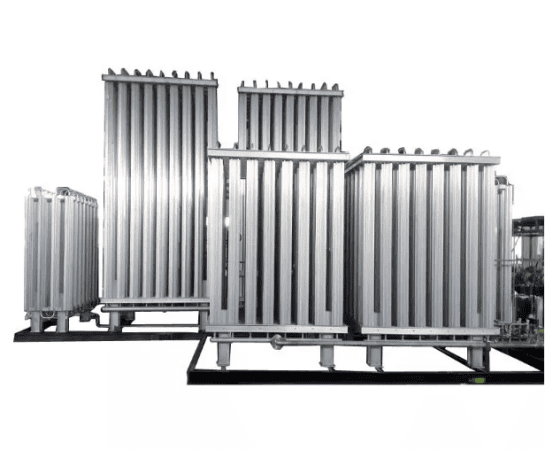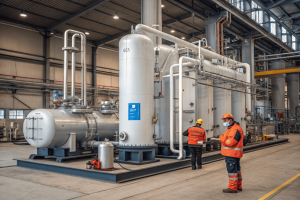What are the corrosion and material selection issues specific to CO2 recovery equipment?
•
What are the corrosion and material selection issues specific to CO2 recovery equipment?
Your plant is silently being eaten from the inside out. Wet carbon dioxide creates an acidic environment that corrodes standard steel, leading to costly leaks and downtime. This hidden threat can jeopardize your entire operation.
The main issue is that wet CO₂ forms carbonic acid, which is highly corrosive to carbon steel. Therefore, material selection must focus on stainless steels like 316L or higher alloys for all "wet" sections, while carefully managing amine chemistry to prevent stress corrosion cracking.
I’ve been in facilities where they tried to save money by using carbon steel in a "mostly dry" part of the system. A few months later, they had a pinhole leak that forced an emergency shutdown. The combination of CO₂, water, and pressure is a brutal one. Investing in the right materials isn't an expense; it's the most critical insurance policy you can buy for the long-term health and safety of your plant. Understanding how these systems work, and where they are vulnerable, is key to building something that lasts.
What safety protocols are required for handling and transporting high-pressure liquid CO2?
High-pressure liquid CO₂ is a silent and invisible danger. A leak is not just a leak; it's a rapidly expanding cloud of gas that can cause asphyxiation and severe frostbite.
Essential safety protocols include robust pressure relief systems, continuous CO₂ gas detection in enclosed areas, and mandatory personal protective equipment (PPE). Proper ventilation and rigorous emergency response training are also non-negotiable for anyone working near the equipment.

I always stress to my teams that CO₂ is a double threat. First, it’s an asphyxiant. It is heavier than air, so in the event of a leak, it sinks and displaces oxygen from the bottom up in enclosed spaces. You wouldn't even realize you are in danger until it is too late. Second, when liquid CO₂ depressurizes, it gets incredibly cold due to the Joule-Thomson effect, reaching temperatures of -78°C (-109°F). This can cause severe cryogenic burns on contact. We design systems with multiple layers of safety, from the materials we choose to the instruments we install.
Here’s a breakdown of the key safety layers:
- Equipment Design: All vessels and piping must be built to handle high pressures and low temperatures, following strict codes like ASME. Pressure relief valves are critical to prevent over-pressurization.
- Monitoring Systems: We install fixed CO₂ gas detectors in any room or pit where the gas could accumulate. These are tied to audible and visual alarms.
- Personal Protective Equipment (PPE): Anyone working directly on the high-pressure liquid system must wear, at a minimum, cryogenic gloves and a full-face shield.
- Training: Workers need to understand the specific risks of CO₂. We run drills for leak scenarios so that the emergency response becomes second nature.
What kind of preventive maintenance is essential for membrane modules or PSA beds in a recovery system?
Your system's performance is slowly dropping. The CO₂ purity is down, and the recovery rate is not what it used to be. Ignoring the health of your system's core components leads to a slow death in efficiency.
For membranes, essential maintenance is all about upstream filtration to prevent fouling and regular integrity tests. For PSA beds, the focus is on protecting the adsorbent from moisture and ensuring the fast-acting switching valves are functioning perfectly.
The heart of any modern physical separation system is either a membrane module or a PSA bed. I think of them like the lungs of the system—they do the hard work of breathing in the mixed gas and breathing out the pure CO₂. And just like lungs, they are very sensitive to what they breathe. Protecting them from "dirty" gas is the single most important maintenance activity. A cheap pre-filter that gets changed on schedule can save you from having to replace an incredibly expensive membrane bundle or an entire PSA vessel of adsorbent material.
Protecting the Core Components
Preventive maintenance for these systems is about vigilance and protecting surfaces.
| Component | Key Preventive Maintenance Task | Consequence of Neglect |
|---|---|---|
| Membrane Module | Regularly change upstream filters (oil, particulate) | Irreversible fouling, reduced separation efficiency |
| PSA Bed Adsorbent | Monitor inlet gas dryer performance | Adsorbent contamination, loss of capacity |
| PSA Switching Valves | Periodic inspection and servicing of seals and actuators | Incomplete separation, leaking, system shutdown |
For membranes, it’s about preventing tiny particles or oil aerosols from sticking to the surface and blocking the pores. For PSA, the biggest enemy is often water vapor, which can permanently ruin the adsorbent material. Beyond filtration, the mechanical health of the PSA system is critical. The valves cycle thousands of times a day, and a single worn-out seal can throw off the entire pressure swing cycle.
How is the potential environmental impact of amine solvent degradation products (e.g., nitrosamines) managed?
You're capturing CO₂ to be environmentally friendly, but your process itself could be creating harmful byproducts. The amines used in solvent systems can degrade, creating a new, hidden environmental challenge.
This is managed by using stable amines, controlling operating temperatures to minimize degradation, and most importantly, using a solvent reclaimer. A small slipstream of the amine is continuously distilled to remove harmful degradation products like nitrosamines, which are then disposed of safely.
When I'm designing an amine plant, responsible solvent management is a top priority. It's not just about capturing CO₂; it's about doing it cleanly. The amine solution is the lifeblood of the system, and we have to keep it healthy. Over time, exposure to oxygen and high temperatures in the reboiler can break down the amine molecules. Some of these breakdown products, like nitrosamines, are a real environmental concern.
There are three primary strategies we use to manage this:
- Prevention through Process Control: First, we do everything we can to stop the degradation from happening. This means keeping the reboiler temperature as low as operationally possible and designing the system to prevent oxygen from getting in.
- Using Additives: We can use special chemicals called inhibitors that are added to the amine solution to slow down the degradation reactions.
- Removal with a Reclaimer: This is the most important tool. A reclaimer is essentially a small distillation unit. It takes a small, continuous stream from the main loop, boils the good amine away to be returned to the system, and leaves behind a concentrated sludge of degradation products and heat-stable salts. This sludge is then safety contained and sent to a specialized waste facility for proper disposal. This ensures the harmful compounds never leave the plant.
Conclusion
Proper material selection is fundamental to preventing corrosion in CO₂ systems. Beyond that, robust safety protocols, diligent preventive maintenance, and responsible solvent management are essential for ensuring a capture facility is safe, reliable, and truly beneficial to the environment.
You may also be interested in:

Why is CO₂ recovery technology gaining popularity worldwide?
Why is CO₂ recovery technology gaining popularity worldwide? You see headlines about carbon capture everywhere. But you wonder if it's
Read more
How is a CO₂ recovery system designed to fit different industries?
How is a CO₂ recovery system designed to fit different industries? You're under pressure to implement a CO₂ recovery solution.
Read more
How energy-efficient are today’s CO₂ recovery technologies?
How energy-efficient are today’s CO₂ recovery technologies? You want to recover CO₂, but you fear that high electricity bills will
Read more